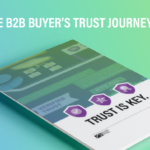Get Closer to Your HealthTech Buyers by Getting Rid of Technology Bias [Updated]

HealthTech has a real bias problem. Everyone thinks they’ve got the best product on the market, and they’re shouting it from the rooftops. But, is that what your buyers really want to hear about?
It’s time to eliminate product bias from your HealthTech marketing efforts. Instead, approach each marketing interaction with these five principles in mind.
Think About This
- B2B companies, including HealthTech, have shifted much of their focus from internal efficiency to customer experience.
- Five years of digital transformation were concentrated into ten months because of the onset of the COVID-19 pandemic. Medicine adopted multiple new technologies in 2020 and more are expected in 2021 including augmented reality, virtual reality, and blockchain.
- 20.4 billion devices were predicted to be connected to the Internet of Things by the end of 2020. Reality eclipsed predictions and reached 31 billion. With the advent of 5G, experts expect another 20% growth in 2021.
The #1 Marketing Mistake You Can Make
Leading with a technology bias is the biggest mistake you can make in marketing — it immediately puts distance between you and your audience.
If you work in technology, it can be easy to assume that everyone knows what you’re talking about all the time. You live and breathe your industry, and as a marketer, it’s your job to share your company’s message. In your personal life, you may find yourself deep in conversations with friends and family about your work, only to realize that they have no idea what you’re really saying. And that’s because they aren’t immersed in your industry or company.
The same thing can happen with your customers and prospects. If you lead with your technology solution, rather than focusing on their problems, you’ll lose them.
Take a step back and understand the bias you project in your company’s marketing initiatives.
How to Eliminate Technology Bias
Healthcare’s rapid digital transformation over the last two years has focused on making the patient journey simpler while improving outcomes. According to BDO, 93% of all healthcare organizations started new digital projects in 2021. Major efforts have been cranked up in telemedicine, EHR interoperability, and patient communication—all borne out of a patient-centric philosophical shift.
That same customer focus needs to permeate the HealthTech industry. Being customer-centric requires you to remove bias about your own products from the messages you share in the early stages of the buyer’s journey. But, eliminating this bias is easier said than done.
Bias exists in the:
- way you speak
- words and phrases you write
- way information is presented to both internal and external audiences
John Farkas, CEO of Golden Spiral, discusses the bias problem in this video.
Follow these five principles to shed your technology bias and create a relatable and approachable brand.
1. Don’t Assume Anything
We all hate the feeling of being in a room full of people talking about a subject we know nothing about. In 2016, I was late to the game on the Netflix phenomenon that is Stranger Things and continually found myself in group settings where everyone but me was referencing Eleven, EggoⓇ waffles, and the Upside Down. These were all words I knew, of course, but without appropriate context, I had no idea how they related to each other.
It all came together for me when I finally watched the first three seasons (season four debuts in 2022); I needed to see the characters and plot in action to really understand what the show was about. Your buyers may have the same experience if you assume they know what you do and how you fit into their space.
That’s why it’s important not to take a “features-first” approach in your marketing interactions. You understand the ins and outs of your product, but your prospects don’t and are likely not ready for that. Before you assume anything, give them the full picture of who you are.
2. Listen First
Successful marketers don’t just excel at communicating; they also excel at listening. You can’t craft a message about your solution if you don’t know what problem it solves. Take time to get to know your customers and prospects without letting your mind wander to which features and benefits you need to push. Remain fully present in phone, video, and in-person meetings. You may find that they have different problems that you can solve but in a different way.
In a presentation at Content Marketing World, Liz High, Vice President of Customer Experience Insight and Delivery at Metia, shared about the three sides in content marketing: the brand’s, the customer’s, and the truth. You reach the truth or “mutual resonance” when you find out what matters to both your brand and your audience.
When you prioritize listening, you won’t waste time and effort solving for a problem you think exists, and can instead develop customer-centric marketing messages that align with your business.
3. Make Your Customer the Hero
You may have heard it before: you’re not the hero of your marketing story, your customer is. After all, at the end of the day, your customers are the ones in the trenches of your industry, working to deliver better results for their customers.
Your marketing messages should instead position your company as a mentor that provides technology to support your customer’s job and drive success. While not new, the “customer hero” approach to marketing has not fully taken hold in the healthcare space; it requires a fundamental change to how you speak to your buyer
Simplify ASC understands what it means to make its customer the hero of the ambulatory surgery center (ASC) world. The company offers an integrated ASC management platform that streamlines clinical and business workflows for surgery centers. But, that’s not the focus of Simplify’s marketing efforts; instead, it’s the nurse administrators who lead the centers.
Take for example the Simplify home page. From human images to problem-driven content, the company makes it clear it understands who its buyers are and what they face every day. This provides a launching point for sharing about a technology solution to make administrators’ jobs easier.
4. Simplify the Message
Specialized, product-driven language filled with industry jargon will make your brand seem unapproachable and out of touch with your audience. That’s why the old phrase “keep it simple stupid” applies to so many contexts, including marketing content. You want to position your technology as robust and sophisticated, not difficult and convoluted.
Create quality content that makes sense to people inside and outside your company and industry. Your website visitors shouldn’t need to do additional research to figure out what you do; it should be clear from the get-go. Focus groups and A/B testing can provide valuable insight to guide content development, helping you determine which messages resonate with your audience and which ones fall flat.
Remember, if your best friend doesn’t understand what you mean when you talk about your company or product, your buyer may not understand, either. Simplicity is essential.
5. Share Real World Stories
One way to eliminate technology bias in your marketing is to talk less about your company and products and more about your customers. You want to show you have a purpose not only to sell great technology but to make real change in your industry that improves people’s day-to-day business lives.
According to Robert Rose, founder and chief strategy officer of The Content Advisory:
“Our brand story says what we want people to believe about us, and our brand’s stories must demonstrate why that belief is a universal truth the audience should believe.”
Customer case studies and testimonials help shape your brand’s stories by creating a narrative about your customer’s (the hero’s) journey before and after using your technology.
360 View, a technology provider for community banks and credit unions, did this with a case study featuring Lakeland Bank.
This case study example veers from the typical “Problem>Solution>Results” format to instead focus on the bank’s mission of making banking simple and the teams that work to achieve this mission. Rather than detailing technology features and benefits, the narrative highlights the real business value the platform delivers for real people at a real bank.
Be an Agent of Change
Technology represents change for most companies, and change doesn’t always make people feel at ease. In fact, it’s often seen as something to be wary of because it pushes us to do things differently and move beyond our comfort zones.
As a B2B tech marketer, your job is to make this change compelling—not terrifying—for your buyers. This happens when you get your head out of your technology and start focusing on who your buyers are, the real problems they face, and what they actually need from you. You’ll then find that your product bias naturally gets pushed to the side, and you’ll be able to execute marketing initiatives more effectively.
Contact Golden Spiral Marketing for more details today. Updated from January 15, 2021


